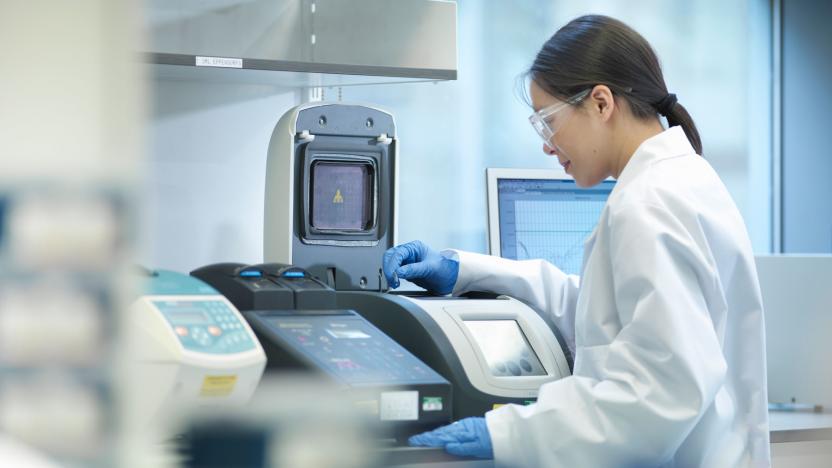labs
Latest

You can now generate AI images directly in the Google Search bar
As long as you've opted-in to Google SGE, the search bar will double as a generative AI image prompt.

Twitter gives paid 'Blue' subscribers early access to more new features
Twitter has rolled out Labs for its Blue subscription service, which will give its paid users early access to select experimental features.

Racing to make coronavirus tests
Labs know how to make COVID-19 tests, but making enough is proving to be a huge challenge.

EVE Evolved: Making ISK from the Crius release
EVE Online's economy has been studied over the years for its resemblance to the real world, and it is often cited as an example of a hyper-capitalist society with no laws or regulation. But underneath the emergent interplay of supply and demand that has fueled everything from freighter businesses to virtual investment banks, EVE is ultimately a game. The biggest influence on the markets by far has always been CCP Games and the changes it deploys in expansions, which shake the universe up and force players to adapt to new circumstances. There's always money to be made from major gameplay changes, and accurately predicting how an expansion will impact on the market can put you on the head of a short-lived but very lucrative gold rush. Though EVE's updates now come in the form of ten smaller releases per year, the upcoming Crius release scheduled for July 22nd has practically a whole expansion's worth of changes to industry and research. That gives you just over two weeks to prepare for the change, train any skills you might need, and figure out how to cash in on EVE's industrial revolution. In this edition of EVE Evolved, I run down some tips for how to prepare for the upcoming industry revamp in Crius and make some ISK.

uChek raises the stakes in smartphone health care with camera-based urine analysis
The iPhone. Is there anything it can't do? The trend towards self-monitoring and informal health tracking continues with uChek. Featured today over at Wired, this app enables you to automatically read, chart and track a variety of urinalysis tests on your iPhone. The product works by leveraging the iPhone's highly sensitive camera to read tints from inexpensive urine dip stick tests. Developed by Mumbai-based Myshkin Ingawale, an MIT grad, the app shifts monitoring away from expensive clinics and into the home. I do worry about lighting variation but I assume there will be calibration of some sort built into the test strips. It's still early days. The website is still creaky. I was unable to sign up for the email list and the shop, which will eventually sell the test strips for US$20 a package, hasn't gone live yet. Here's a TED talk from last year, where Ingawale talks about an earlier invention called ToucHb. It introduced blood tests without needles.

Gmail demotes Quote Selected Text to Labs to help avoid quotational mishaps
Well, that didn't last long. Gmail's handy new Quote Selected Text has received a serious demotion, getting knocked back down to Labs, due to negative user feedback. According to its creators, the addition was causing too much accidental quotation -- and no one wants that, right? If you find yourself missing the feature, you can still enable it with a little help from Labs. No word on plans to move the feature back up to the bigs.

Uncharted 3's latest lab is 5-on-5 SMGs, riot shields, and grenades
Naughty Dog has issued an update to Uncharted 3 with a brand new experimental Lab playlist to play around in. The playlist is going back to a 5v5 format, this time giving players a combination of riot shields, uzis, and grenades to carry out to the battlefield. Kickback and boosters are disabled, too, so it sounds like your best strategy is to be vicious: Shoot everything until you get close enough to stab them in the back.With this update, Naughty Dog also fixed an issue with DLC maps not showing up properly in the rotation, and there's a full rundown of what you'll see when on the company blog. The developer also promises a full schedule for upcoming labs and events soon, as well as more news about a new character coming to the game (from a Sony contest) and other updates in the next patch, 1.13.

Intel funnels $40 million into global network of research laboratories
Like any tech company worth its weight in silicon, Intel puts plenty of cash into research, often partnering with outside labs and schools that are less concerned with turning every project into a multi-billion dollar product. After throwing $30 million at Carnegie Mellon last year to open two new labs, Chipzilla is investing $40 million more in a global network of university research centers. Over the next five years that money will be rolled out to what the company is calling, Intel Collaborative Research Institutes (ICRI). The ICRI are based on the same premise as Intel's Science and Technology Centers, like those opened at Mellon, except with a global reach. Two existing labs, the Intel Visual Computing Institute at Saarland University and the Intel-NTU Connected Context Computing Center at National Taiwan University are being rolled into the program. In addition, three new centers are being opened up, including ICRIs for Sustainable Connected Cities in the United Kingdom, Secure Computing at the Technische Universität Darmstadt and Computational Intelligence at the Technion-Israel Institute of Technology. For more info on what sort or work they'll be doing at the various labs check out the PR after the break.

EVE Evolved: Preparing for the Inferno expansion
The Inferno expansion is set to launch on Tuesday May 22nd, promising a complete revamp of EVE Online's war declaration system and a whole host of new modules. If you're in a wardec corp, you'll need to make a few adjustments to the way you operate when the patch goes live. The minimum war fee will increase to 50 million ISK even if you're declaring war on a small corporation, making very small corps less-appealing targets. The fee increases based on the number of members in the target corp, but it doesn't start increasing until around the 130-member mark. If you want to get your money's worth, you'll be best off picking a target corp with 100-150 members or selecting very high-value small targets. Be very wary of wardeccing large alliances after the patch. While the previous war system swung in favour of the attacker, the new system has gone to the opposite extreme. Large corps and alliances are now significantly more costly and dangerous to declare war on, especially as the defender can now call mercenaries into the war at any time. Players have complained that the increasing war costs could be abused by getting all alliance members to add alts to the corp, but this would be a logistical nightmare to apply in practice and would increase fees by only a few hundred million ISK. If alt padding becomes a problem, CCP will undoubtedly step in and revise the fee structure. In this week's EVE Evolved, I look at the new modules and gameplay changes coming in Tuesday's Inferno expansion and give some tips on preparing for the patch.

Perifoveal Display tracks head positioning, highlights changing data on secondary LCDs (hands-on)
If there's a large display as part of your workstation, you know how difficult it can be to keep track of all of your windows simultaneously, without missing a single update. Now imagine surrounding yourself with three, or four, or five jumbo LCDs, each littered with dozens of windows tracking realtime data -- be it RSS feeds, an inbox or chat. Financial analysts, security guards and transit dispatchers are but a few of the professionals tasked with monitoring such arrays, constantly scanning each monitor to keep abreast of updates. One project from the MIT Media Lab offers a solution, pairing Microsoft Kinect cameras with detection software, then highlighting changes with a new graphical user interface. Perifoveal Display presents data at normal brightness on the monitor that you're facing directly. Then, as you move your head to a different LCD, that panel becomes brighter, while changes on any of the displays that you're not facing directly (but still remain within your peripheral vision) -- a rising stock price, or motion on a security camera -- are highlighted with a white square, which slowly fades once you turn to face the new information. During our hands-on demo, everything worked as described, albeit without the instant response times you may expect from such a platform. As with most Media Lab projects, there's no release date in sight, but you can gawk at the prototype in our video just after the break.

Google Play Music switches on labs features: HTML5 player, star ratings and notifications
We're so used to Google Labs features on commonly used services like mail and maps that we often forget they're technically experimental and now Music has a few of its own. The new features available on the desktop version of its web player include toggles for an HTML5 player (there was already a mobile version for iOS) instead of Flash, Gmail-style desktop notifications (Chrome only) and the ability to rate music on a five star scale instead of just thumbs up or thumbs down. There's been a steady of stream of updates to the Music arm of Google Play since it was first announced last May, now that the velvet invite rope has been lifted has it become a part of your daily soundtrack?

Visualized: this gel-filled Sprint head is testing all sorts of futurephones
Chamber testing is most certainly nothing new for your average carrier -- every one of the big boys here in the States already does something similar to this -- but it's not often that we're given an inside look at what exactly happens within those elusive doors. During a recent Sprint campus walkthrough, we peeked into the carrier's network development lab for a glimpse at what it takes to certify a phone for use on its network. Granted, the vast majority of Sprint's testing is done elsewhere across the industry, and we were informed that the yellow dome shown above is actually a minty fresh model that includes "gel" within its borders, seemingly to produce a more realistic testing ground. You know -- because human brains are clearly shrinking, while craniums are being increasingly filled with nondescript fluids. All jesting aside, we were told that this is the place where Sprint ensures Antennagate never comes to its side of town, and every Now Network phone (present and future) has to roll through here before being allowed out. The reason? Sprint needs to be absolutely certain that there's no stray radio emissions bleeding into frequencies that it doesn't support, and of course, to ask the Verizon guy if he can hear him now. %Gallery-128959%

Google 'winding down' Labs, likely due to meddling older sister
Google Labs, that breeding ground for the wacky, sublime, and sometimes useful experiments that Mountain View's scooter-loving employees are so fond of, is getting ready to "wind down." The software giant announced today that the experimental forum for testing out potential features is being sidelined, in order for the company to focus on bigger picture ideas. Some of the more useful experimentation for properties like Calendar and Gmail will stick around, as will the Labs experiments that eventually made their way into the Android market. Google has promised to keep us all in the loop during the transition, so perhaps we can pick up a few secondhand test tubes for our own collections.

Microsoft's OneVision Video Recognizer can detect, identify, and track your face on video... so smile!
Here's your classic case of "just because you can, doesn't mean you should." Microsoft's Innovation Labs have just demonstrated a OneVision Video Recognizer algorithm that's powerful enough to perform face detection duties on a running video feed. It can recognize and track humanoid visages even while they're moving, accept tags that allow auto-identification of people as they enter the frame, and can ultimately lead to some highly sophisticated video editing and indexing via its automated information gathering. Of course, it's that very ease with which it can keep a watchful eye on everyone that has us feeling uneasy right now, but what are you gonna do? Watch the video after the break, that's what.

Yarn-eating Yarn Monster forms yarn balls, makes us want to build our own (video)
Robots, Arduino, and monsters are all very close to our new-age, gadget-loving hearts. The folks over at Union Bridge Labs have created a half-monster, half-machine dubbed the Yarn Monster. This little cubic beast has one job -- to eat yarn and shape it into a perfectly rolled ball of, well, yarn. It's powered by a ton of hardware, from a stepper motor to Arduino components to even a universal mounting hub. Instructions to control speed of the nom-noming are sent to the Arduino via XBee from a remotely connected potentiometer which can also reverse the direction of yarn-ball rolling. We encourage you to spend your hard-earned dough (about $130), buy the proper components and build one of these things to impress your loved ones. If not though, be sure to watch the video after the break.

KDDI develops a zoom-enhance system for HD movie streaming on smartphones (video)
Because not every smartphone has a full 1080p resolution (yet), KDDI's R&D Labs have come up with a new method for massaging the most out of HD movie streams while on the move. You'll still be able to pummel your poor mobile device and connection with the full-res stream, should you wish it, but KDDI's innovation is in developing a system whereby you can zoom in on particular parts of the feed, have the stream cropped to your requirements on far-off servers somewhere, and then receive only the stuff you want to see onto your device. And because of your phone's aforementioned pixel deficiency, the employment of this technique will most often result in negligible picture fidelity loss, if any. The biggest benefit, however, might be to carriers like KDDI who end up having to carry less data back and forth, even if it does come at a slight server-side cost. Video after the break.

HP Labs teams up with Hynix to manufacture memristors, plans assault on flash memory in 2013
The memristor's come a long way since being hypothesized back in 1971. If you ask HP Labs, the history of this particular memory technology didn't hit its next milestone for almost four decades, when the company produced the very first memory resistor chip. Just last month, the Labs group proved its little transistor could handle logic and data storage, and as of today, the company's announcing a joint development agreement with Hynix Semiconductor, with a goal of bringing these chips to the market -- and rendering flash memory obsolete. That challenge against flash (not a very popular naming convention these days, it seems) was thrown down by HP Labs Senior Fellow Stan Williams, who posits that the memristor is "an universal memory that over a sufficient amount of time will replace flash, DRAM, magnetic hard disks, and possibly even SRAM." But onto the immediate, albeit aspirational goal (i.e. not a commitment, which he stressed on multiple occasions): Williams hopes to see the transistors in consumer products by this time 2013, for approximately the price of what flash memory will be selling for at the time but with "at least twice the bit capacity." He also claims a much smaller power requirement of "at least a factor of 10" and an even faster operation speed, in addition to previously-discussed advantages like read / write endurance. With Hynix on board, the goal is to make these "drop-in replacements" for flash memory, whereby the same protocols and even the same connectors will work just fine. For HP, however, Williams says there'll be an initial competitive advantage for the company due to its comfort level with memristors' unique properties, but that other companies will be encouraged to license the technology and experiment with new possibilities in hardware design. Williams wouldn't give any specific product examples where we might initially see the memristor, except to repeat that it'll be anywhere and everywhere flash memory is. Fighting words, indeed. We normally don't get excited about minute hardware components -- not often, at least -- but we gotta say, the seeds of the future look mighty interesting. Can't wait to see what germinates. Highlights from our talk with Williams after the break. %Gallery-100780%

Inside Apple's 'black lab' wireless testing facilities (update: video)
It's not surprising that after Apple finished explaining the iPhone 4 antenna issues to the press today, the company wanted to go one step further and say "yes, actually, we do test the hell out of these phones before we release them to the public." Though Steve Jobs went over the lengthy and intensive kinds of radio evaluation that goes on at Apple's headquarters, it didn't seem to be enough for the folks in Cupertino. And that, we suspect, is why we were invited (along with a small group of other journalists) to take a brief tour of Apple's Infinite Loop labs. Though we weren't allowed to shoot video or take pictures, we can tell you about what we did -- and what we didn't -- see and hear behind closed doors.

Video: Nokia Braille Reader makes SMS tactile
Nokia labs is serving up a potentially helpful application for the blind and visually impaired. The beta app makes SMS messages visible through tactile feedback on a Nokia braille reader developed in partnership with Tampere University and the Finnish Federation of the Visually Impaired. It runs in the background and automatically opens when a new SMS is received. It's available to download and test on Nokia devices based on S60 5th Edition. Check the demonstration after the break, maybe someone you know could benefit.

Engadget Labs: The best point-and-shoot camera for under $400
The summer looms, and so too does the summer vacation season. Despite the economy there are visions of great trips brewing in the backs of peoples' minds, visions that will soon turn into (hopefully) great memories -- and (hopefully) great pictures. Some folks wouldn't dream of going on those trips without an SLR slung 'round their neck or hanging at the hip, but then there are plenty of others who'd much prefer something a little more pocketable. Even for aspiring photographers there are times when lugging around five pounds of glass just isn't going to work. There are dozens and dozens of cameras intended for casual shooters all the time or serious shooters some of the time, with models suitable for pockets of every shape and size -- and for wallets of equally varying dimensions. So, let's take a look at some of this summer's greatest, and see which comes out ahead, shall we?










